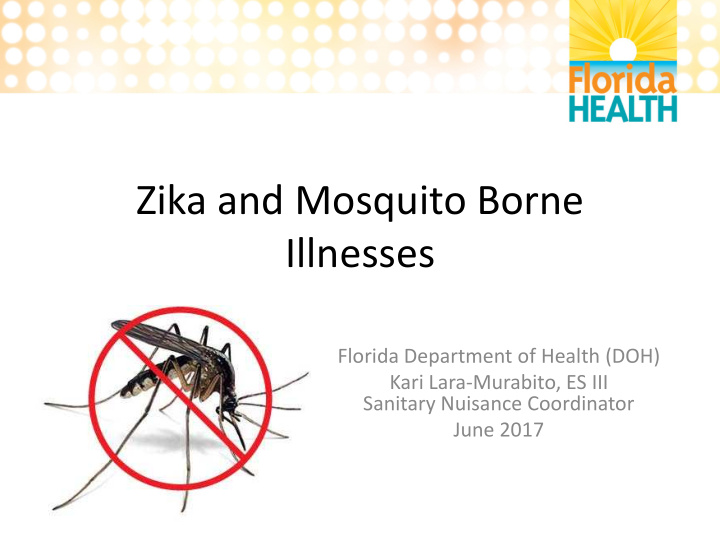



Zika and Mosquito Borne Illnesses Florida Department of Health (DOH) Kari Lara-Murabito, ES III Sanitary Nuisance Coordinator June 2017
Outline • Mosquito borne diseases • What is Zika? • Why is Zika a public health risk? • Aedes aegypti vs. Aedes albopictus • What is DOH – Orange doing? • Breeding locations and mosquito fish? • How can you help?
Mosquito-Borne Diseases • Chikungunya virus • West Nile virus • Dengue • Malaria • Yellow Fever • Encephalitis • Zika • Rift Valley Fever Anopheles sp.
Chikungunya
Chikungunya
Dengue and West Nile Virus
Malaria https://www.cdc.gov
Yellow Fever
Other mosquito borne illnesses • Eastern Equine Encephalitis • St. Louis Encephalitis • La Crosse Encephalitis • Rift Valley Fever
What is Zika? • Originally identified in Africa and Southeast Asia – First identified in Uganda’s Zika Forest in 1947 • Virus spreads to people through the bite of an infected Aedes species mosquito • Passed from pregnant woman to her unborn child – Microcephaly • No vaccine or medicine for Zika
MICROCEPHALY
Zika in the US
Zika • Fever • Incubation period: 2-14 days • Rash • 1 in 5 people become • Joint pain symptomatic • Red eyes • No vaccine • Pregnant and nursing women can use EPA- approved mosquito repellent
Ae. aegypti vs. Ae. albopictus
Ae. aegypti vs. Ae. albopictus
DOH - Orange • Collaboration with Mosquito Control – 7 part-time Zika employees
Sanitary Nuisance • 386.01 Sanitary nuisance.—A sanitary nuisance is the commission of any act, by an individual, municipality, organization, or corporation, or the keeping, maintaining, propagation, existence, or permission of anything, by an individual, municipality, organization, or corporation, by which the health or life of an individual, or the health or lives of individuals, may be threatened or impaired, or by which or through which, directly or indirectly, disease may be caused.
Florida Statute 386 FS 386.03(2) FS 386.041(1)(e) • The Department of Health • The creation, maintenance, may remove or prevent the or causing of any condition continuing sanitary capable of breeding flies, nuisance condition mosquitoes, or other arthropods capable of transmitting diseases, directly or indirectly to humans
SN Process • Complaint received (usually green pool) • Notice to Abate • Notice of Intended Action • If the SN is still not corrected, we abate the condition
Recommend
More recommend